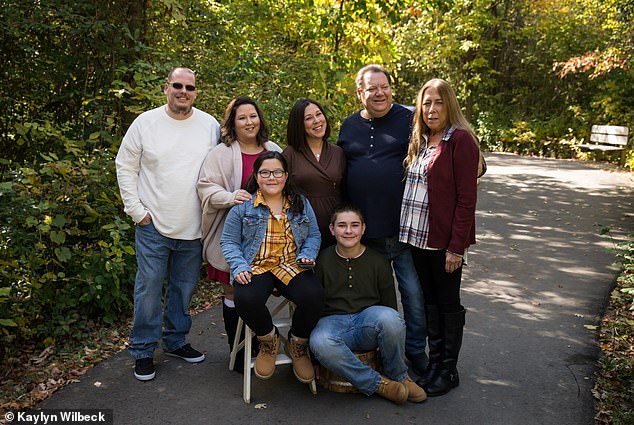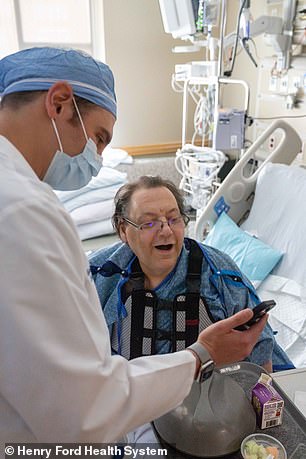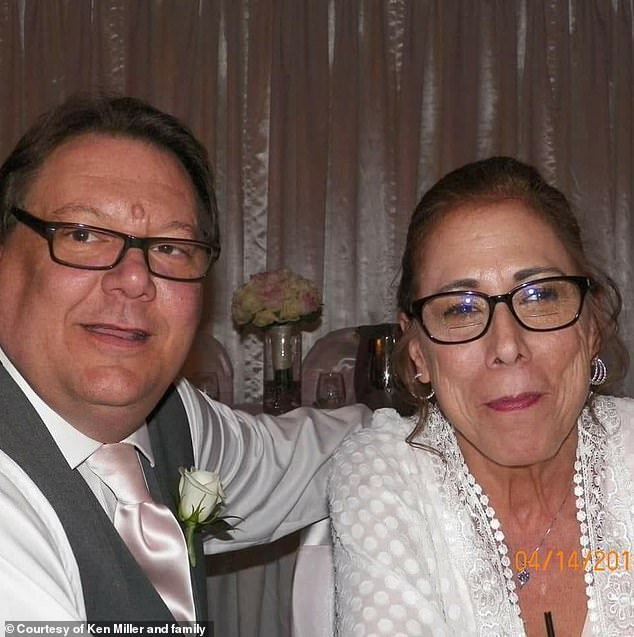A Michigan man’s “heart in a box” surgery is the first in the state to transplant a beating organ into a patient
A Michigan man has become the first in the state to receive a new “miracle heart” that was transplanted while it was still beating.
Ken Miller, 58, battled heart failure for more than a decade after suffering a heart attack in 2013.
The event forced him to quit his 30-year job in the dairy industry, and doctors told him there was little they could do until he received a new heart.
Over the next few years, Mr. Miller’s heart became so damaged that it grew to twice its normal size and he also developed kidney failure.
But on his 58th birthday, the father and grandfather heard that he would receive a new heart and a new kidney, which he said would ‘give him new life’.
“I just think it’s a miracle,” he said.
Ken Miller, 58, became the first patient in Michigan to receive a beating heart transplant (pictured here with chief surgeon Dr. Kyle Miletic)

Mr. Miller, a father and grandfather, had suffered from congestive heart failure for more than a decade after a heart attack. He also received a new kidney
Mr. Miller is one of 70 Americans to have a beating heart transplant. This procedure is intended to meet the demand of more than 3,500 people in the US waiting for a heart transplant.
Normally, during a heart transplant, the organ is capped, removed from the deceased donor and transported to the hospital on ice.
However, these organs can only remain viable on ice for about four hours, meaning they can only travel a certain distance to get to the recipient.
This limits the number of organs available to the people who need them.
But a ‘heart in a box’, which continues to pump during transport, remains usable for longer, meaning it can be transported further away and is accessible to more patients.
Dr. Kyle Miletic, a heart and transplant surgeon at Henry Ford Hospital in Detroit who led the procedure, said in a press release: ‘The heart in a box is a kind of mini heart-lung machine that we use in traditional open-heart surgery. Surgeons take the heart in the donor hospital and place it on this machine.’
“The machine restarts the heart and gives it all the blood and nutrients it needs to stay healthy. So while it’s traveling to Henry Ford Hospital, the heart never loses its blood supply and it never stops beating until you take it off the machine.”
The heart stopped only once, when it was first removed from the donor, and was placed still beating in Mr. Miller’s chest.
Stopping the heart just once can reduce recovery time and the risk of future complications.
“Although this was more challenging than surgery on a stationary heart, the heart was much stronger and more robust than we normally see after the traditional method,” said Dr. Miletic.
He added: ‘If you stop the heart a second time, it weakens it and there is a greater chance that the heart will need mechanical support after the transplant, which can lead to a longer recovery time for the patient.
“But if the heart only has to stop once, the muscle stays stronger and the patient outcomes are better.”
After the procedure in May, Mr. Miller required no additional medical support and he – and his new heart – are recovering well.


Mr. Miller is one of only 70 Americans to receive the groundbreaking surgery. He said he now looks forward to small activities like walking his dog, Chip (right)

“I knew I would need a new heart at some point. I never thought it would be this special,” said Mr. Miller, pictured here with his late wife Liz.
It is unclear how long the procedure took, but a traditional heart transplant takes about six to 12 hours.
Because Mr. Miller’s original heart had grown so large, Dr. Miletic said the team had more room to operate, reducing the risk of complications.
“It’s more challenging because you’re sewing in moving tissue, but this patient was ideally suited for this transplantation method,” Dr. Miletic said.
He added: ‘This was also his first operation. When patients have previously undergone open heart surgery, subsequent surgeries may be complicated due to the presence of scar tissue.
“In this case the conditions were almost perfect for us.”
According to the team, Miller’s new organ has traveled hundreds of miles.
The first-ever beating heart transplant was performed last March by a team at Stanford University, which they called “revolutionary.”
Mr. Miller is now looking forward to enjoying the little things he has missed, like climbing stairs and walking his dog.
He said: ‘I’m living comfortably with my rescue dog Chip, and I’m excited to get home and relax and get back to normal – to see my children and grandchildren, to sit down and play my guitar again.
“I’m so grateful to these doctors for being able to say that. I knew I would need a new heart at some point. I never thought it would be this special.”
